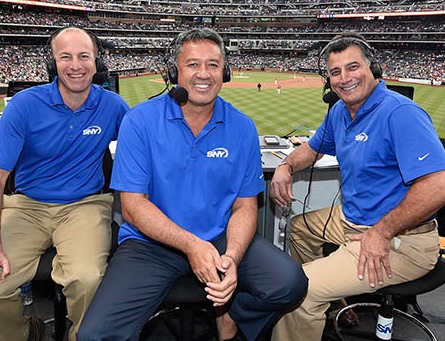The Five Spot: Ron Darling

While some ballplayers turned broadcasters fill the airwaves with jaunty reminiscences about their time in baseball, former pitcher Ron Darling brings intense preparation and an astute reading of the game to viewers.
Darling won a World Series with the New York Mets in 1986. He joined play-by-play announcer Gary Cohen and analyst (and former teammate) Keith Hernandez in the Mets booth in 2006. The trio offers a heady mix of sophisticated observations and witty banter; even the snarks at Awful Announcing noted their “smooth chemistry and refreshing candor,” adding they’re “considered by many to be the best broadcast booth in MLB.”
Thirty years after the Series win, Yale grad Darling wrote Game 7, 1986: Failure and Triumph in the Biggest Game of My Life, about his dismal start in the historic game. Darling prefers watching edgy dramas such as Billions, Vinyl and Better Call Saul rather than sports. “When you have this kind of job,” he says, “binge-watching is the only way you can do it.” B&C deputy editor Michael Malone spoke with Darling. An edited transcript follows.
The book reads like it was cathartic for you. It definitely was. I didn’t pitch particularly well in (Game 7), but when we won, no one was happier than I was running onto the field. At the parade a day later, no one was happier riding in the convertible in front of 3 million fans. But a few days later, sitting in my apartment, you start to reflect. For professional athletes, you’re pretty great at what you do athletic-wise from 6 years old. Most big moments you come up big, but I didn’t. After that Series, I had great years with the Mets and the Oakland A’s. I didn’t think it would be that big a deal, but it still stuck in my craw 30 years later.
What makes the Mets broadcast booth work so well? When we’re at our best, we’re kind of like free-form jazz—whoever is hot can take the ball and run. If offense is a big part of the game and Keith is spot-on in his analysis, he can take up much of the broadcast. And we’ve eliminated some of the noise, the traffic that happens in a three-man booth. Keith does the hitting, I do the pitching and Gary does his thing.
Who are your role models in broadcasting? Tim McCarver is where we all want to go. He transformed the sport, making it a thinking man’s game. When you listened to games in the ’50s and ’60s, the ex-player usually said very little. There’s not a lot of analysis, just anecdotal hilarity. McCarver did a great job of weaving those wonderful stories in, but also having the teaching moments.
How do you prepare for a game? I read everything I can get my hands on. I try to digest it all and have an original thought about it. I read or listen to people I respect, take what they say about the game, and put it in my gray matter. If you have 100 different takes on [former Pirates and current Mets 2nd baseman] Neil Walker [returning] to Pittsburgh, I want to come up with No. 101.
Broadcasting & Cable Newsletter
The smarter way to stay on top of broadcasting and cable industry. Sign up below
With the pace of the game, and a young generation used to immediate gratification, do you feel the need to evolve the broadcast? We try to do that with Twitter and trivia questions, but I think we have to be a little more interactive. I don’t know exactly how to do that—the suits have to decide how that goes. But interaction with our young fans is going to have to be paramount moving forward. The other day Keith and I played catch with some young kids. That doesn’t seem like a huge thing, but I think it’s something that should be thought about in terms of young people being more involved with the booth.
Michael Malone is content director at B+C and Multichannel News. He joined B+C in 2005 and has covered network programming, including entertainment, news and sports on broadcast, cable and streaming; and local broadcast television, including writing the "Local News Close-Up" market profiles. He also hosted the podcasts "Busted Pilot" and "Series Business." His journalism has also appeared in The New York Times, The L.A. Times, The Boston Globe and New York magazine.

